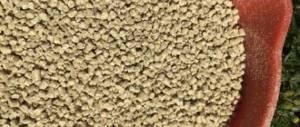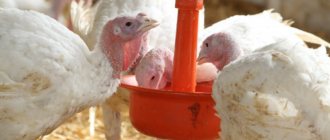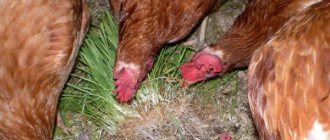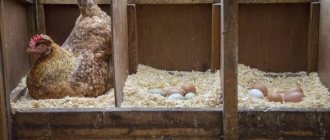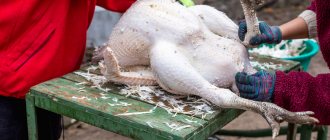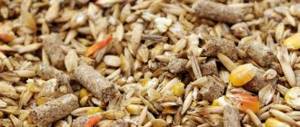Good afternoon, experienced and novice poultry farmers! Can barley be fed to broilers, or is it only good for laying hens? Now let's put everything into pieces. The nutrition of broilers differs significantly from the nutrition of laying hens. But let’s say right away that laying hens and broilers can have a little barley, although they don’t like it very much. We train it from chicken age.
Laying hens need an increased amount of calcium in their feed to ensure strong egg shells, and a minimum of components that contribute to rapid weight gain. But broilers need calcium only for bone growth, and at the same time, their diet should contain many substances that are aimed at rapid weight gain.
The basis of any feed for broilers - factory-made or home-made - consists of grain crops, making up more than 65% of their composition. Many poultry farmers are interested in whether it is worth including barley in the feed and whether it is harmful to the health of broilers. In this article we will look at the benefits of this type of grain for chickens, how and when to give barley to broilers.
Composition of grain crop
Barley has a unique beneficial composition, which contains everything a bird needs. The calorie content of the grain crop is almost 280 kcal per 100 g of product. Barley contains amino acids:
- lysine;
- cystine;
- methionine;
- isoleucine.
The grain crop is rich in calcium, phosphorus and other useful microelements. 75% of barley is carbohydrates, which make the bird strong and energetic. There is also a high content of water-soluble dietary fiber beta-glucans. They are the ones who cleanse the body of harmful substances.
Thanks to the B complex of vitamins, as well as vitamins A, E and D, the full development of the bird occurs:
- the condition of cartilage and bone tissue improves;
- immunity increases;
- the skin remains healthy.
How to feed?
Dosage
The dosage of oats in the diet of black-bush must be precise. In general, this product should not exceed 10-20% of the total grain and vegetable part of the chicken menu.
In this case, the birds are given oats that have been pre-hulled and soaked or steamed in water for a day. The product can be mixed with other grains (for example, rye, herbs, vegetables, animal feed).
If a chicken eats a ready-made grain mixture that already contains 10-20% oats, then it should not be given separately as a supplement, provided that the chicken does not shed.
Young animals under the age of 30 days are given peeled oats 2-3 times a week in crushed form or in the form of flakes.
Its amount should not exceed 20% of the weight of the feed, since fiber can cause blockage of the muscular part of the stomach in chickens, which will cause the babies to die.
In summer
In the warm season, chickens eat more varied food than in winter. They graze a lot, receiving greenery in abundance. At this time, the proportion of oats in the diet can be reduced to 10-15%.
in winter
Oats are the second grain crop, after wheat, necessary to maintain the egg production of chickens.
In cold weather, it should be steamed or germinated before giving to the bird. In order for females to lay eggs regularly and produce healthy offspring, they must receive at least 30 g of grains per day.
The benefits and harms of barley for broilers
Among the positive qualities of this grain crop are:
- due to the high carbohydrate content of barley, birds quickly gain weight;
- protein contributes to the full development of the chick;
- dietary fiber improves the digestion and absorption of basic food;
- Vitamin B in barley speeds up metabolism.
Among the disadvantages, a peculiarity of the structure of the grain is noted - it is covered with a filmy shell, which consists of difficult-to-digest fiber. Its excess provokes disruption of the gastrointestinal tract and can lead to death. Therefore, unpeeled barley should be excluded for broilers. Before giving it to your bird, be sure to remove all shells from the grains.
We recommend that you read: is it possible to give green onions to broilers?
Use as feed
The optimal time for feeding cattle with barley is the period of pregnancy and milking. However, it should not be removed from the diet for the rest of the time, because it strengthens the immunity of animals, making them more resilient and increasing resistance to disease, and increases the meatiness of both large and small livestock.
Barley is usually given as part of concentrated feed (a mixture of barley, peas, beans and soybeans). The amount of such feed for cattle is determined by milk yield, at the rate of 150-300 grams of barley for every liter of milk. Please note that exceeding this norm can lead to metabolic disorders of the animal! Concentrated feed is used in dry form or by adding water.
It is customary to feed livestock three times a day, with the first two meals being the most suitable for feeding barley. If mixed nutrition is used, then concentrated food is given first, followed by succulent food (root vegetables, corn), and the final stage is roughage (for example, bran).
In what form to feed
There are several options:
- In the form of coarse grains.
- Sprouted barley grain. It is introduced into the diet of birds in winter and autumn. It is distinguished by high digestibility and enhanced taste properties. In order to obtain sprouted grains, you need to place them in containers, fill them with water and leave them for a day in a dark, warm place. Over the next two days, the container should be taken out, the water drained, the grains washed and refilled with clean water. The capacity should ideally be located near the battery. As soon as the sprouts appear, you can feed the birds. A handful of product per day is enough for 10 individuals.
- Sprouts with roots. After 7 days, the sprouts will stretch up to 10 cm. They should be cut, chopped and given to the birds along with the roots.
- As part of a grain mixture. In addition to barley, it should contain wheat, corn, millet and peas. All cereals must be ground into flour.
- Like part of the porridge. To do this, boil a kilogram of small fish ground in a meat grinder in two liters of water. Then add a bucket of ground grain mixture to the broth, stir and leave for steaming. After the porridge has cooled, add finely chopped herbs to it.
We told you more about when you can feed mash to broilers here.
Sprouted barley is an ideal way to diversify the diet of chickens
If dry grain should be added to the feed in limited quantities, then when barley germinates, a large amount of vitamins and nutrients is formed in it, so this option will only benefit the bird.
Germination of barley is carried out in several stages:
- The grain is poured into a wide bowl with small sides, after which the grain layer is filled with water.
- The dishes are placed in a warm place - this is required for faster swelling of the barley.
- The next day, excess water is drained. Next, the grain is washed and again poured into a bowl with water.
- The next morning the procedure is repeated, with the grain only half immersed in water.
- The container with barley should be kept in a warm room; the grain should be periodically sprinkled with water to keep it moist on top.
- After sprouts appear, food can be given to chickens. It is desirable that the sprouts are about 3 cm long - in this case the grain will be as beneficial as possible for the bird.
Is it possible for chickens to feed barley?
Important: feeding chickens with barley sprouts should be in the proportion of 250 g of barley per 10 chickens.
A balanced feed from cereal crops will not only help increase the productivity of chickens, but will also saturate the bird with health and energy, which is very important in the spring, when many poultry farmers begin to collect eggs for incubation.
Types of broilers, chicken feeding conditions
As a result of crossing different breeds of chickens, breeders were able to develop meat species that are famous for their productivity. Proper rearing of broilers and appropriate feeding of the birds gives quick results - after 40 days the young animals reach a weight of 2.5 kg and are ready for slaughter.
In order for broiler breeds to quickly gain weight, you need to follow the feeding rules. Already from 12 hours of life of chickens, they should be fed with special feed.
If you feed broilers for 80 days, the bird will reach a weight of 4 to 4.5 kg. And if cockerels and hens are kept separately, the weight increases to 5.5 kg
The technology of feeding broilers requires that from the first days of life they receive all nutrients, including vitamins and minerals, in the correct proportions. Now on sale there are special formulations for feeding day-old chicks and young animals. You do not need to scrupulously calculate the amount of products needed by grams. The chicks will receive all the necessary substances and microelements for rapid growth, and the price of food from the manufacturer is affordable for everyone.
If you notice that the chicken is lethargic and does not approach food, isolate it from the rest. During this period, feed with a mixture of yolk and milk from a pipette (for 10 chicks, 1 yolk and 50 ml of milk). When he gets better, release him to the main group
In addition to special grain mixtures, the following must be included in the diet of young animals:
- Finely chopped and boiled root vegetables, fresh vegetables.
- Bread and crackers soaked in water (no more than 5% of the total food volume).
- Fresh herbs and special herbal flour.
Clue. Broilers have a very fast metabolism. In order for their weight gain to continue, it is necessary to provide them with constant access to food. If a meat chicken is hungry, it quickly loses weight
For proper nutrition of young animals, modern industry produces special additives and premixes. By giving them in the required quantity, the breeder does not have to worry about what to feed broiler chickens. When purchasing dietary supplements, be sure to get instructions that indicate the amount of impurities. Their number directly depends on the age of the bird.
By providing proper care for chickens with adequate nutrition, survival rates will be 97-100%
Feeding chickens with grain in winter and summer
Feeding chickens in summer and winter is slightly different. Then what kind of grain should I feed laying hens in cold and hot seasons so that they can lay eggs well?
In principle, you can always give one mixture to avoid confusion. But in the summer, breeders usually save money. Since the bird finds protein and vitamins in abundance on the street, it can not be given corn and barley and, moreover, it can be completely switched to wheat, without adding other cereals.
Winter diet for cage-laying hens of the White Russian breed of chickens
In winter, birds need more energy, they must gain a little fat so as not to die from the cold - this is the natural protection of any bird and animal. Therefore, in winter, it is worth feeding laying hens a mixture of all of the above grains, including expensive rye, if possible. A typical winter grain mixture contains: 40% wheat, 20% barley, 20% corn, 10% rye and 10% oats.
Do-it-yourself compound feed: 2 recipes
You can feed chickens not only with ready-made food, but also with food you prepare yourself at home.
Let's look at several available recipes
Recipe No. 1
At the head of this composition is wheat.
Mix wheat (about 650-670 g) with sunflower meal or cake (about 200 g). Add limestone flour (75-80 g), meat and bone meal (50-55 g), sunflower oil and yeast (25-30 g each) to the resulting mixture. The composition can be supplemented with a vitamin complex.
Recipe No. 2
The main ingredient in this recipe is corn. So, you will need:
- corn – 450-500 g;
- wheat - about 160 g;
- barley and sunflower meal – 80-110 g of each ingredient;
- meat and bone and fish meal – 70 and 60 g, respectively;
- yeast and herbal flour - 50 g each;
- peas – 30 g;
- salt on the tip of a knife.
A complex of vitamins is added to the finished mixture, similar to the previous recipe, if desired.
Composition of feed for laying hens at home
Which grains to choose to create the healthiest mixtures? Since grain should predominate in the composition of the feed, it is necessary to clarify which types of grains are best suited for laying hens, and how best to feed them.
Almost all grain crops are easily digested by birds, supplying the body with carbohydrates, fiber and vitamins. When deciding what to feed laying hens so that they lay eggs better, the poultry farmer should think about introducing poultry into the diet:
- corn rich in carbohydrates, and its grain is pre-crushed so that the feed is absorbed more fully and better;
- wheat, which stands out from other cereals due to its abundance of vitamins B and E, plant proteins, especially in demand by laying hens;
- wheat bran, even superior to whole grain in nutritional value for laying hens;
- barley, useful for chickens of meat and meat-egg breeds;
- fiber-rich oats, which for better digestion must be crushed and steamed, otherwise its unrefined grain irritates the esophagus and intestines of chickens;
- oat bran, which is an excellent substitute for grain and can account for up to 20% of the volume of cereals in the menu;
- rye and millet;
- buckwheat, which should be no more than 10% of the feeding norm for laying hens at home.
But even the most balanced cereal mixtures do not have enough protein, calcium, especially necessary for laying hens, phosphorus and some important vitamins, so other components must be included in the menu.
A useful additive in the diet of laying hens will be:
- flax and sunflower seeds;
- legumes;
- Cake and meal rich in protein and fiber.
The menu must include mineral supplements that are unacceptable for the human diet, but birds simply cannot do without them. These are chalk, crushed shells, fine gravel, ash, and table salt. The listed feed components are not included in the feed for laying hens, but are given separately.
How feed barley grows
Six-row barley is grown for fodder production. On each ledge of the ear shaft there are three grains; on the sides they are small and curved. Grain yield depends on the type and fertility of the soil and on external factors: light, temperature, moisture.
Non-acidic chernozem soil is suitable for growing this crop. Nutrients and moisture should easily penetrate into the soil. Feed barley grows better in the south of the country, where daylight hours are longer. The optimal average temperature for good germination and full maturity is +20…+22°C.
Feed barley requires moisture during the periods of germination and main growth. The application of mineral and organic fertilizers helps retain moisture. Grain does not like to grow for three years in the same place. The best predecessors of barley are winter rye, potatoes and legumes (chickpeas, lentils, peas).
Features of cultivation
Breeding broilers at home for beginners is possible using two methods:
- Extensive.
- Intense.
Let's figure out what their differences are. In the first case, raising chickens at home is carried out seasonally. Young animals are purchased in the spring and sent to slaughter by mid-summer. In winter, the bird does not breed.
In the second case, the bird is bred all year round. Young animals are purchased every three months. Poultry is sent for slaughter 1.5–2.5 months after purchase.
If you plan to breed broilers in your country house, you need to evaluate the available area for keeping the birds. Taking into account this area, birds can be bred in two ways:
- Outdoor breeding.
- Cell breeding.
Outdoor breeding
For floor breeding of broilers, more space is needed than for cage breeding. They can be placed in a small building. If you plan to raise poultry all year round, you need to take care of insulating this room. You can use heating devices.
Rules for keeping poultry outdoors that must be followed:
- The floor in the poultry house must be covered with a layer of lime. A 10-centimeter layer of sawdust is laid on top of it - this material absorbs moisture well and is quite economical.
- For day-old chicks, the house must be illuminated 24 hours a day.
- The room must have good ventilation.
- For the first 2 weeks of a bird’s life, the house must have an appropriate temperature – no less than +26 and no more than +33 degrees.
- Birds that have grown up to one month of age are kept in the house at a temperature of +18 to +20 degrees.
- The humidity level in the chick room is maintained at 65–70%.
The bird is very sensitive to changes in temperature, especially if we are talking about sudden changes. Therefore, its indicators need constant monitoring
More attention should be paid to this point in winter, when the ambient temperature is low.
Cell breeding
Keeping broilers in cages is the best option when the area used is small. Cages can be placed in one tier or in several, which is important for breeding large numbers of birds.
The advantage of keeping young animals in cages is the savings on bedding materials. Since this bird is inactive, it easily gets used to limited space. Therefore, the cells do not need to be made too large. One square meter can accommodate 18 chickens or 9 adults.
When raising poultry in cages, it is necessary to adhere to the recommended temperature regime - from 34 to 35 degrees. Ventilation must be provided in cages. In all other respects, the requirements for cage breeding of broilers do not differ from floor keeping.
Breeding broilers in an incubator
Breeding broiler chickens at home is also possible by laying eggs in an incubator. This will reduce the cost of purchasing young animals.
In order for the offspring to be healthy, it is necessary to choose the right eggs to put into the incubator chamber. To do this, it is recommended to take them from chickens whose age does not exceed 2 years and does not suffer from infectious diseases. It should be noted that sexual maturity of this type of poultry occurs no earlier than 7–8 months of age.
Requirements for eggs for incubation:
- The average size. If you take small eggs, then there is a high probability that the young ones will not be distinguished by their large weight and size. In the case of large eggs, you may encounter damage and cracks in the shell. This happens because the shells of large eggs are not strong enough.
- Correct form.
- Same weight.
- Uniform color.
All this time, the eggs are stored in a cool, dark place. The incubation period lasts 21 days.
Despite the fact that female broilers are weak layers of eggs, they are good brood hens. Therefore, they can quite cope with hatching offspring. Only in this case the number of chicks hatched will be significantly less than in the case of an incubator.
